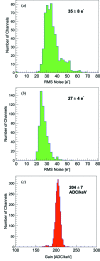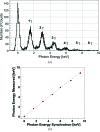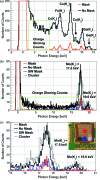Towards hybrid pixel detectors for energy-dispersive or soft X-ray photon science
- PMID: 26917124
- PMCID: PMC5297903
- DOI: 10.1107/S1600577515023541
Towards hybrid pixel detectors for energy-dispersive or soft X-ray photon science
Abstract
JUNGFRAU (adJUstiNg Gain detector FoR the Aramis User station) is a two-dimensional hybrid pixel detector for photon science applications at free-electron lasers and synchrotron light sources. The JUNGFRAU 0.4 prototype presented here is specifically geared towards low-noise performance and hence soft X-ray detection. The design, geometry and readout architecture of JUNGFRAU 0.4 correspond to those of other JUNGFRAU pixel detectors, which are charge-integrating detectors with 75 µm × 75 µm pixels. Main characteristics of JUNGFRAU 0.4 are its fixed gain and r.m.s. noise of as low as 27 e(-) electronic noise charge (<100 eV) with no active cooling. The 48 × 48 pixels JUNGFRAU 0.4 prototype can be combined with a charge-sharing suppression mask directly placed on the sensor, which keeps photons from hitting the charge-sharing regions of the pixels. The mask consists of a 150 µm tungsten sheet, in which 28 µm-diameter holes are laser-drilled. The mask is aligned with the pixels. The noise and gain characterization, and single-photon detection as low as 1.2 keV are shown. The performance of JUNGFRAU 0.4 without the mask and also in the charge-sharing suppression configuration (with the mask, with a `software mask' or a `cluster finding' algorithm) is tested, compared and evaluated, in particular with respect to the removal of the charge-sharing contribution in the spectra, the detection efficiency and the photon rate capability. Energy-dispersive and imaging experiments with fluorescence X-ray irradiation from an X-ray tube and a synchrotron light source are successfully demonstrated with an r.m.s. energy resolution of 20% (no mask) and 14% (with the mask) at 1.2 keV and of 5% at 13.3 keV. The performance evaluation of the JUNGFRAU 0.4 prototype suggests that this detection system could be the starting point for a future detector development effort for either applications in the soft X-ray energy regime or for an energy-dispersive detection system.
Keywords: energy-dispersive detectors; hybrid detectors; instrumentation for FELs; instrumentation for synchrotrons; soft X-rays.
Figures








Comment in
-
Hybrid pixel array detectors enter the low noise regime.J Synchrotron Radiat. 2016 Mar;23(2):383-4. doi: 10.1107/S1600577516002721. Epub 2016 Feb 25. J Synchrotron Radiat. 2016. PMID: 26917123 No abstract available.
References
-
- Admans, G., Berkvens, P., Kaprolat, A. & Revol, J.-L. (2014). Editors. ESRF Upgrade Program Phase II (2015–2022), Technical Design Study. ESRF, Grenoble, France.
-
- Amptek Inc. (2015). Amptek Silicon Drift Diode (SDD) at High Count Rates, Application Note AN-SDD-001 Rev B0. Amptek Inc., Austin, TX, USA.
-
- Arthur, J., Bergmann, U., Brunger, A., Bostedt, C., Boutet, S., Bozek, J., Cocco, D., Devereaux, T., Ding, Y., Dürr, H., Fritz, D., Gaffney, K., Galayda, J., Goldstein, J., Gühr, M., Hastings, J., Heimann, P., Hodgson, K., Huang, Z., Kelez, N., Montanez, P., Robert, A., Rowen, M., Schlotter, W., Seibert, M., Stöhr, J., Turner, J., White, W., Wu, J., Williams, T., Yachandra, V. & Yano, J. (2012). Science Driven Instrumentation for LCLS-II, White Paper Outlining Science and Scope of Instrumentation.
-
- Arthur, J., Materlik, G., Tatchyn, R. & Winick, H. (1995). Rev. Sci. Instrum. 66, 1987–1989.
-
- Bergamaschi, A., Cartier, S., Dinapoli, R., Greiffenberg, D., Jungmann-Smith, J. H., Mezza, D., Mozzanica, A., Schmitt, B., Shi, X. & Tinti, G. (2015). J. Instrum. 10, C01033.
Publication types
LinkOut - more resources
Full Text Sources
Other Literature Sources
Molecular Biology Databases

